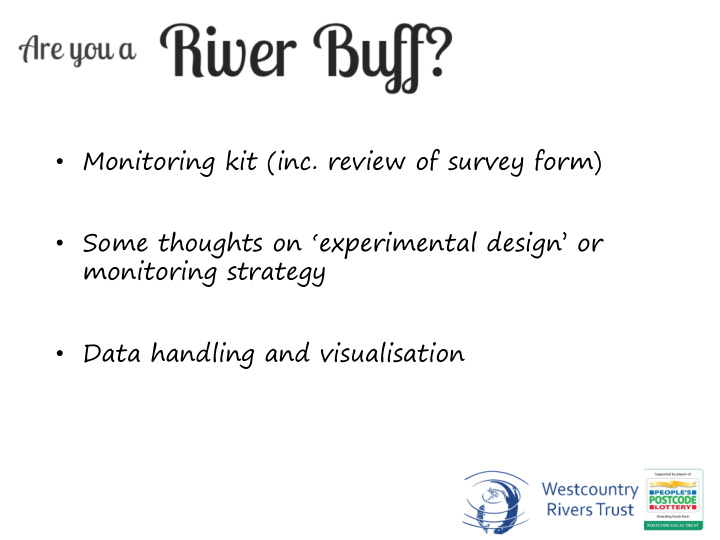



• Monitoring kit (inc. review of survey form) • Some thoughts on ‘experimental design’ or monitoring strategy • Data handling and visualisation
M ONITORING K IT H ACH P OCKET T ESTER Measures temperature and electrical conductivity which it uses to calculate total dissolved solids – a measure of the amount of ‘stuff’ dissolved in the water.
M ONITORING K IT T URBIDITY T UBE A way of measuring the optical clarity of the water The tube has a black and white disc at the bottom and a graduated scale up the side. The tube is gradually filled with sample until the disc just disappears. The number on the scale that corresponds to the water level in the tube is read off as the turbidity
M ONITORING K IT H ANNAH P HOSPHATE C HECKER (a.k.a. The ‘Green Egg’) Uses a chemical reagent that forms a blue colour in the presence of phosphate The more phosphate the deeper the colour The phosphate checker measures the blue colour and converts that to a phosphate concentration measured in parts per million (ppm) equivalent to milligrams per litre (mg/l)
M ONITORING K IT With these simple instruments we can measure: − the amount of dissolved solids in a sample − the amount of suspended solids in a sample − the amount of phosphate in a sample − the temperature This helps us to identify parts of the river catchment that are producing the highest levels of pollution It also helps us to know what is ‘normal’ and therefore when conditions are different from normal
Total Dissolved solids (mg/l) M ONITORING K IT Water level (m)
S URVEY F ORM
S URVEY F ORM The survey form has sections for: ONLY THESE ARE COMPULSORY S URVEY DETAILS L OCATION , TIME , DATE , OBSERVER NAME ETC . G ENERAL E COSYSTEM O BSERVATIONS L AND USE , BANKSIDE VEGETATION , P ROBLEM P LANT S PECIES , W ILDLIFE SIGHTINGS E VIDENCE OF POLLUTION P OLLUTION SOURCES , DIFFUSE POLLUTION , RECENT POLLUTION R IVER CHANNEL OBSERVATIONS C HANNEL DIMENSIONS , FLOW , WATER LEVEL , WATER QUALITY , SUBSTRATE N OTES AND PHOTOS N OTES OF ANYTHING UNUSUAL / NOT COVERED BY THE FORM
U SEFUL R ESOURCES www.gridreferencefinder.com Website for identifying co-ordinates of a point
U SEFUL R ESOURCES www.bing.com/mapspreview Online OS mapping at 1:25000 scale (Explorer)
U SEFUL R ESOURCES www.environment.data.gov.uk/catchment-planning/
E XPERIMENTAL D ESIGN O PTION #1 ‘L ONG T ERM ’ DATA FROM A SINGLE POINT = SAMPLING POINT
E XPERIMENTAL D ESIGN O PTION #2 U PSTREAM AND DOWNSTREAM OF A POINT SOURCE OR AREA OF CONCERN = SAMPLING POINT
E XPERIMENTAL D ESIGN O PTION #3 C OMPARISON BETWEEN TWO ( OR MORE ) SUB - CATCHMENTS OR TRIBUTARIES = SAMPLING POINT
E XPERIMENTAL D ESIGN O PTION #4 BLITZ!! = SAMPLING POINT
E XPERIMENTAL D ESIGN W HAT WE ’ RE TRYING TO AVOID IS …. = SAMPLING POINT
D ATA H ANDLING Fill out and send in the paper forms either by post or scan and email Shortly you will be able to enter data and upload it via the Westcountry CSI website
D ATA H ANDLING This will let us all see the data points and photos on a map background along with data values, time series and photos
A NY QUESTIONS ?
Water Quality Monitoring POLLUTANTS: SOURCES: Nitrate Sewage treatment works Phosphate CSOs Ammonia Farm land / farm yards Polluting organic matter Septic tanks Road runoff Road drains ‘Grey’ water Urban misconnections Sediment Industrial discharges Bacteria – coliforms / e. coli PARAMETERS: Temperature Colour Electrical Conductivity Coloured dissolved organic matter Total Dissolved Solids pH Nitrate Tryptophan Phosphate Optical Brightening Agents Ammonia Redox / ORP Dissolved oxygen Turbidity Suspended Solids
Recommend
More recommend